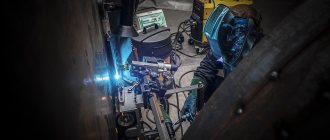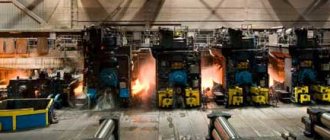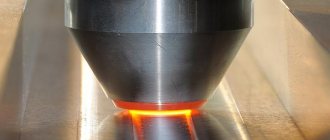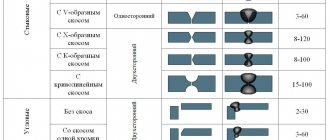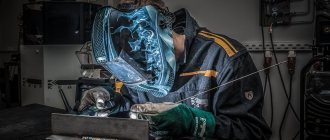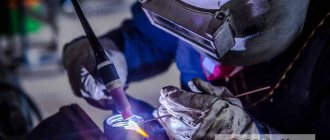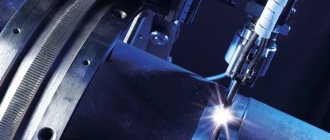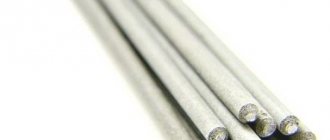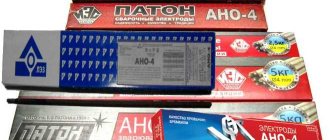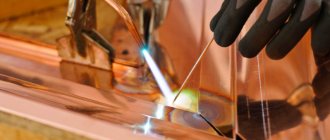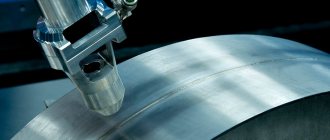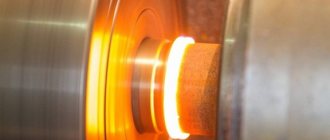In recent years, plasma welding technology has spread to all industries, including construction and household repairs, and is increasingly replacing traditional types of welding. This is due to the very great advantages of this technology over already known ones.
First of all, the quality of the seam, then, minimal warping of parts, and finally, high purity and waste-free technology. The energy intensity of such welding is approximately the same as other types, and sometimes exceeds them.
Description and scope of plasma welding
The main difference between this method of joining parts is the high heating temperature (up to 8000 °C). The weld pool is protected by an argon environment. The cooling system prevents a critical temperature increase.
Without this block, the plasma torch melts and the working area heats up to 30,000 °C.
The essence of welding lies in the ability of argon to take on the state of plasma under the influence of an electric arc.
The current, which is a plasma generator, changes the physical properties of the electrically conductive gas.
Plasma welding is used to join workpieces made of materials with a high melting point. Most often, units of this type are used on production sites. Less common are models for work in home workshops.
Application area
Thanks to working at temperatures reaching up to 30,000 degrees, the technology allows you to work with many types of metals: stainless steel, carbon steel, cast iron, copper, brass, bronze, titanium, aluminum and others. Together with the high precision of work, this leads to the following areas of use of the technology:
- food industry;
- energy sector;
- chemical production;
- jewelry making;
- mechanical engineering;
- instrument making;
- medical equipment;
- production of high precision parts.
We recommend! How semi-automatic welding works: device, principle of operation, technology
Types of technology
The methods differ in equipment operating parameters, scope of application and some other characteristics.
Direct action
The principle of operation of the unit when exciting an electric arc is the same as in electric arc welding: one contact is connected to the electrode, the other to the workpiece. A powerful arc is formed, falling on the metal.
Plasma is produced as follows:
- the terminal is connected to the nozzle, the gas entering the plasmatron is ionized;
- After the contact is transferred to the part being welded, the arc hits the material, the plasma is removed from the nozzle.
To understand what direct plasma welding is and how to work with this method, you need to know that the power of the heated gas jet depends on the current strength. Argon not only maintains a stable arc, but also prevents oxygen from entering the weld pool.
Indirect action
The operating principle of welding machines of this type is based on the following processes:
- Connecting one pole to the infusible electrode, the second to the plasma torch.
- Excitation of an electric arc. The power is determined by the argon pressure in the plasma-forming installation. During ionization, the gas heats up and increases in volume. Argon during indirect welding is consumed more slowly than with direct technology.
- Feeding an arc onto metal with great force. The area being treated melts.
We recommend reading Features of electroslag welding
With the indirect method, a stable arc is maintained, and the plasma temperature is lower than with direct welding. The installations are used for spraying powders, obtaining thermal effects, and joining materials with low electrical conductivity. Shielding gas is supplied automatically.
Do-it-yourself plasma torch: with some skill and minimal knowledge it’s not difficult
For welding work with home appliances, a simple installation is done. To obtain an electric arc, a step-down transformer of 30-50 V, with a power of 200-300 W, is sufficient. Electrode holders are made from electrical terminal blocks and a pencil . The wood is cut with a stationery knife in several places around the circumference, then the lead is carefully removed.
Manual and stationary holders of graphite rods are glued together using improvised materials. They will participate in the generation of plasma. To avoid damaging the retina, it is better to work in special safety glasses.
Flux is made by adding water to boric acid or borax . Clamps for welded parts are made from scrap materials. To warm up both parts of the future whole, connect them with two terminals to one pole of the transformer, the second pole to the graphite rod holder. The joint is coated with a paste-like flux. You can start working.
Working principle of plasma welding
The nature of the functioning of the devices depends on the method of adjusting the parameters.
Manual method
For simple operations on joining non-ferrous and ferrous metals, equipment that does not have automatic control units is used. After the plasma arc appears, the master brings the torch to the part with one hand, and with the other he feeds consumables into the weld pool.
By moving the tool and filler along the joint, the welder forms a strong weld. The manual welding process can be carried out without wire.
Using automation
Such plasma welding machines are used at production sites. The operator controls all parameters remotely.
There are automatic installations of the following types:
- for connecting sheets of metal or pipes;
- single-pass for welding with wire;
- multi-pass;
- for the formation of reinforcing powder coating.
Automatic penetrating arc devices are often used to weld aluminum and aluminum-based alloys.
Requirements and conditions for using the technology
The following requirements apply to plasma arc welding:
- Before starting work, the arc is “twisted”. This is explained by the possibility of decay. “Twist” helps to form a stable thin arc, because the gas quickly ionizes. The part is exposed to a powerful thermal effect, concentrated at one point. This is where melting occurs.
- When welding, you need to maintain a powerful arc. It is capable of melting any metals and alloys, regardless of their thickness and physical properties. The parts are heated to the melting point and even boiling.
- The weld pool is protected with inert gas - argon, acetone vapor, nitrogen. The nozzle simultaneously supplies plasma and protective medium. Therefore, the melt does not interact with air. The material does not oxidize, the seam acquires high strength.
Advantages and disadvantages
The advantages of the plasma method include:
- Availability. The plasma torch can be installed on basic welding machines.
- Uniformity of the welded joint. Due to the high temperature, a uniform, thin seam is formed in the treated area.
- Ability to control metal penetration.
- High performance. The high speed of seam formation reduces the labor intensity of the work.
- Wide scope of application. The universal method is used to join workpieces made of other materials.
The negative qualities of this welding method include:
- high cost of the plasma torch and work;
- difficulty in execution (the welder is required to have special skills);
- the need for additional care of the devices (you need to regularly clean the plasmatron, replace the electrode and burner);
- the need for a continuous supply of argon to the apparatus;
- the need to cool the main equipment components;
- high energy consumption.
We recommend reading: Pros and cons of laser welding
Disadvantages when used at work
In addition to its advantages, plasma welding has several negative aspects, because of which it turns out to be less optimal than similar ones. Below we will look at what shortcomings it contains:
- increased cost;
- due to the dissipation of energy in space, the atmosphere and the metal of the electrode, it has a reduced efficiency factor (efficiency);
- ensuring the supply of water and plasma-forming gas;
- Difficulty in use makes it unsuitable for normal or everyday work.
How to use plasma welding
To work using this method, the welder must have a permit and comply with safety requirements.
General provisions and rules
When working with plasma equipment, consider the following recommendations:
- before starting welding, prepare the place and special clothes for the master;
- check the serviceability of the main elements of the device, the pressure in the cylinders;
- weld aluminum and its alloys at low current;
- the plasma torch is purged before starting welding work;
- novice craftsmen use microplasma welding (this method is considered safer);
- An experienced welder independently chooses the most convenient technology for himself.
Safety precautions
The following labor protection requirements apply to the work process:
- When welding using the plasma method, the likelihood of electrical injury increases. Do not use cables with damaged insulation and refuse to use a dielectric mat.
- As the current increases, the noise level increases. In this case, use hearing protection - headphones, earplugs, and a noise mask.
- To protect the respiratory system, craftsmen install a local exhaust hood from melt vapors and gases.
- To prevent damage to the visual organs, glasses with light filters are used.
Working with non-ferrous metal
When welding such materials, a lower exposure temperature is required. However, due to the high thermal conductivity, the power of the electric arc must be quite high.
The difficulty of welding may lie in the oxidation of non-ferrous metals under the influence of oxygen, but most oxides are easily reduced.
The presence of organic oxidizing radicals in the plasma - aqueous-alcoholic or acetone solutions - is sufficient.
Thin-walled metals
When welding and cutting such workpieces, the torch should not be brought too close to the work area. In this case, the likelihood of through defects in the seam increases. The plasma arc pressure on the material is higher than a simple one. The welding current is maintained at 12-14 A. Sometimes lower values are sufficient.
An example of assembling a installation for cutting and welding large parts
An argon sleeve is used to supply gas. You will need an oscillator and two chokes. The holder is made from improvised materials, using a tungsten rod and a copper insulator machined from a copper tube. The cone nozzle for supplying argon is also made of copper. The inventor considers the drawback to be purging with argon supplied from a cylinder. Factory-made devices operate on compressed air.
Industry today is developing rapidly. New welding techniques emerge every year, which are beginning to become popular in modern private construction. These methods often make work easier, but do not lose their safety and functionality compared to previously invented methods. One of them is plasma welding and melting of parts.
Content:
The essence of plasma welding
Plasma welding is used for soldering stainless steel, steel pipes and other metals. Plasma welding is a process in which local melting of metal occurs using a plasma flow. Plasma is an ionized gas containing charged particles that can conduct current.
The gas is ionized when heated by a high-speed compressed arc that flows from the plasma torch. The higher the temperature of the gas, the higher the level of ionization will be. The arc temperature can reach 5000-30000 degrees Celsius. Plasma welding technology is similar to the argon welding procedure. However, a conventional welding arc cannot be classified as a plasma arc, because its operating temperature is much lower - up to 5 thousand degrees.
Of all the types of effects on metals, plasma welding is considered the most common, because in modern heavy industry stainless steels, non-ferrous metals, special alloys and some alloys of non-ferrous metals have begun to be used, and for these materials gas and other treatments are considered ineffective.
A plasma arc is a more concentrated heat source that can weld large, thick metals without cutting edges. Due to its cylindrical shape and the possibility of significantly increasing the length, such an arc allows you to carry out plasma welding with your own hands in hard-to-reach places and when the distance from the product to the torch nozzle changes.
Principle of operation
To transform a conventional arc into a plasma arc, to increase the power and temperature of a conventional arc, it is customary to use two processes: compression and the procedure of forced injection of plasma-forming gas into the arc. In the process, it is customary to use argon as a plasma-forming gas, sometimes with the addition of hydrogen or helium. Argon must also be used as a shielding gas. The electrode material is tungsten doped with thorium, yttrium and lanthanum, as well as copper and hafnium.
Read also: Drill a hole in concrete for a pipe
The arc is compressed by placing it in a special plasma torch, the walls of which are intensively cooled with water. The transverse compression of the arc decreases as a result of compression and, as a result, its power increases - the energy per unit area.
A plasma-forming gas, heated by the arc, is injected into the plasma arc region simultaneously with compression, ionized and increased in volume by a hundred times due to thermal expansion. The kinetic energy of ionized particles contained in the plasma-forming gas complements the thermal energy that is released in the arc as a result of electrical processes occurring. Therefore, plasma arcs are called more powerful energy sources than conventional ones.
In addition to the high temperature, the main features that distinguish a plasma arc from a conventional arc are: a smaller diameter of the arc, the pressure on the metal of the arc is six to ten times greater than that of a conventional arc, the cylindrical shape of the arc along with the usual conical one, the ability to maintain the arc at low currents - about 0.2–30 Amperes.
Two plasma welding schemes are possible: plasma arc welding, in which the arc burns between the product and the electrode, and plasma jet, when the arc burns between the plasma torch nozzle and the electrode and is blown out by gas streams. The most common is the first scheme.
Advantages of plasma welding
The following advantages of plasma welding and melting of metals compared to classical methods are highlighted:
- You can use a plasma welding machine to work with almost all metals - cast iron, steel, aluminum with its alloys, copper with its alloys.
- The cutting speed of metal, which has a thickness of 50 - 200 millimeters, is 2-3 times higher than when carrying out gas welding.
- There is no need to use acetylene, argon, oxygen or propane-butane, which significantly reduces the cost of operating a plasma device.
- The precision of the seams during melting and welding, as well as the quality of the procedures, virtually eliminates future edge processing.
- The metal does not deform during welding, even if it is necessary to cut out a complex configuration or shape. Plasma welding technology allows the cutting procedure to be carried out on an unprepared surface - painted or rusty. When cutting a painted structure, the paint in the arc area does not ignite.
- Safe work, because when using a plasma cutter, gas cylinders are not used. This factor is responsible for the environmental friendliness of such work.
Types of plasma welding
Do-it-yourself plasma welding is currently considered a fairly common process, the popularity of which is quite obvious. Depending on the current strength, there are three types of plasma welding: microplasma, medium and high current. By choosing a certain type, you will find out how much plasma welding costs on your own.
Microplasma welding
Microplasma welding is considered the most common. Due to the high level of gas ionization in a special plasma torch and the use of tungsten electrodes, which have a diameter of 1–2 millimeters, the plasma arc is capable of burning at an extremely low current, starting from 0.1 Ampere.
Special low-ampere DC power supplies are designed to produce a pilot arc that burns continuously between a copper water-cooled nozzle and an electrode. When the plasma torch is applied to the product, the main arc, powered from the source, is ignited. The plasma-forming gas is supplied through the plasma torch nozzle, which has a diameter of about 0.5–1.5 millimeters.
Microplasma welding is a very effective way of fusing products that have a small thickness - up to 1.5 millimeters. The diameter of the plasma arc reaches 2 millimeters, which allows heat to be concentrated on a limited area of products and heat the welding area without damaging the adjacent area. Such an arc allows you to avoid burn-throughs, which are typical for ordinary argon-arc welding of thin metals.
The main gas used as a protective and plasma-forming gas is argon. Depending on the metal being welded, various additives are added to it, which increase the efficiency of the plasma metal welding procedure. When welding steel, it is advisable to add 8–10% hydrogen to the protective argon to increase the thermal efficiency of the plasma arc. When welding low-carbon steel, carbon dioxide can be added to argon; when welding titanium, helium can be added.
Installations for the microplasma welding process allow welding in different modes: pulsed or continuous direct polarity, multi-polar pulses, continuous reverse polarity. Microplasma welding has been successfully used in the production of thin-walled containers or pipes, welding bellows and membranes to large parts, making jewelry and joining foil.
Medium current welding
The welding process at medium currents of 50–150 Amps has much in common with the argon arc welding procedure with a tungsten electrode. However, it is considered more efficient due to the limited heating area and high arc power. In terms of energy characteristics, a plasma arc occupies an intermediate position between an ordinary arc and a laser or electron beam.
Plasma welding at medium current guarantees deeper penetration, compared to a traditional arc, with a smaller seam width. In addition to the energy characteristics, this is also explained by the high level of arc pressure on the weld pools, as a result of which the thickness of the layers of liquid metal under the arc decreases and the conditions for heat transfer deep into the base metal improve. The operating principle of plasma welding allows work to be carried out using filler wire.
What are plasma devices?
The units differ in technical characteristics and scope of application. The main classification feature is the current strength of the plasma arc. This value, depending on the type of apparatus, lies in a wide range.
For microplasma welding
The current strength of such units does not exceed 25 A. Despite this, they are quite functional. Microplasma devices are used for joining thin-walled elements, precision and complex work, and cutting metal.
They are easy to use and maintain. The diameter of the burner nozzle is less than 3 mm. The devices operate on direct current. To produce plasma, acetylene mixtures and copper-plated electrodes are used.
Average by current strength
The device, in some respects, resembles a household inverter that produces a current of 50-150 A. However, the scope of application of a medium-current plasma device is not so wide; it is mainly used for cutting sheet metal.
We recommend reading: How to pressure cook
The working gas is often air, but argon or helium can be used. The plasma torch and burner have a complex structure. Some devices are equipped with an additional liquid cooling system.
High current equipment
The device is capable of delivering more than 150 A. Devices of this type are practically not used in domestic conditions and on small construction sites. They are used in large manufacturing enterprises.
The installations have a complex design. The burners are equipped with modern cooling systems. When welding, infusible electrodes alloyed with thorium or beryllium are used.
Equipment and accessories
The kit includes:
- power supply with vertical current-voltage characteristic;
- plasma torch (burner);
- gas and coolant supply system;
- device for fixing a part.
For safe operation, a supply and exhaust ventilation device is required. The power range of the units is from 20 to 250 amperes, they operate on direct current.
Approximate price of inventories on Yandex.market
The price of inverters is from 15 to 500 thousand rubles. In the price segment from 300 to 500 thousand - powerful and multifunctional units that cut, weld and solder metal.
Design and structure of the plasma apparatus
The process of plasma formation takes place in a plasmatron. The unit is a cone open on both sides, in the central part of which a refractory tungsten electrode with alloying additives is installed.
In the lower section of the main block there is a nozzle from which plasma is supplied under pressure. The substance that forms it is a mixture of argon and hydrogen. Gas is forced into the cone through the top hole. When heated, it expands and comes out of the plasmatron as a powerful jet. A nozzle is used to regulate the flow.
Description of the most popular device for plasma welding “Gorynych”
This device consists of 2 separate modules - a plasma generator and a control unit. Water is used as a plasma generator.
The unit is compact in size and has low energy consumption. It is often used in domestic conditions.
The operating principle of the device is as follows:
- Low-temperature plasma is formed due to the arc that occurs between the contacts.
- The water is heated to extreme temperatures. Under pressure it turns into a directed plasma jet.
Any home master can learn to work with the Gorynych device. The device is easy to use; it comes with instructions with a detailed description of connection methods. The unit can be used for welding, cutting, soldering, and extinguishing fire.
Briefly about homemade devices
You can create a simple device for plasma welding with your own hands.
The design includes the following elements:
- Tungsten electrode cathode. It is secured with a screw or welded to a steel holder.
- Handle made of dielectric material – phenol plastic, fluoroplastic.
- Steel or brass cover.
- Gas supply fitting.
- Copper nozzle. The part must be replaceable, because it wears out quickly. The thread between the anode and the nozzle is treated with graphite.
- A distillation cube for supplying vapors of a water-alcohol mixture.
- Welding transformer. It must generate powerful electrical impulses. The secondary winding is made up of a small number of turns of thick copper cable.
An arc is formed after pressing the “Start” key. Initially, the spark ignites in a dry burner. Then the arc switches to current-driven combustion mode. After heating the anode, instead of air, the heated alcohol mixture becomes the working gas.
What can you do with a plasma cutter?
Using a plasma cutter in your own small business, you can produce:
- Elements of decorative or loaded metal structures (for example: gates, fences, balconies).
- Barbecues and fireplaces.
- Garden furniture.
- Metal furniture, fittings and interior elements for modern home or office designs.
Interesting materials:
How to sow Phlox Beautiful Gnome? How to sow annual dahlias? How to sow cucumbers into tablets? How to sow petunia without granules? How to sow beets without thinning? How are horses shoed now? How to form a beautiful crown for a fat woman? How to form the crown of Crassula? How to form a crown for geraniums? How to form Nivaki from pine?
